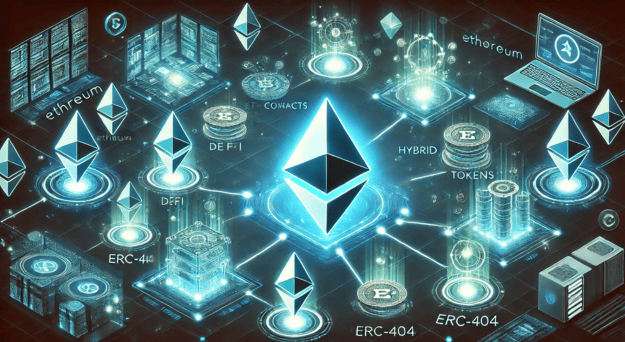As decentralized applications (dApps) continue to evolve across DeFi, NFTs, gaming, and Web3 social platforms, the demand for more flexible and powerful token standards is rising. Enter ERC-404 — the experimental Ethereum token standard that merges fungible tokens (ERC-20) with non-fungible tokens (ERC-721) into a hybrid format.
While ERC-404 is still in its early stages, its potential to reshape how dApps operate is massive. In this post, we’ll explore how ERC-404 is impacting decentralized applications, unlocking new layers of utility, user experience, and financial innovation.
What is ERC-404 and Why Does It Matter for dApps?
ERC-404 combines the liquidity of fungible tokens with the uniqueness of NFTs, enabling tokens that can be fractionally owned, traded, and still carry distinct attributes.
This hybrid structure creates new dynamics for dApp builders by:
- Enabling fractional NFT ownership
- Supporting dual asset behavior (fungible and non-fungible)
- Unlocking more advanced smart contract design
- Encouraging deeper DeFi/NFT integration
For developers building decentralized applications, ERC-404 expands what’s possible with tokenized assets.
1. DeFi: Liquidity Meets Uniqueness
DeFi applications have traditionally relied on ERC-20 tokens for staking, lending, yield farming, and governance. With ERC-404, developers can now:
- Create NFT-backed tokens that are tradable in DeFi protocols
- Build fractionalized staking pools for rare digital assets
- Enable NFT yield farming, where staked tokens correspond to unique NFT drops
- Combine governance rights with unique token traits
This brings new utility and engagement mechanics to decentralized finance platforms that were previously only possible in isolated systems.
2. NFT Marketplaces: Solving the Liquidity Problem
One of the biggest challenges for NFTs has been illiquidity — you can’t sell a piece of an NFT easily. ERC-404 allows dApps to:
- Support fractional NFT trading directly inside the platform
- Integrate with DEX-style NFT liquidity pools
- Offer real-time pricing and token-based trading for collectibles
- Allow users to mint or redeem full NFTs from fractional tokens
This transforms NFTs from static digital assets into dynamic, tradable components within decentralized applications.
3. GameFi: In-Game Assets with Dual Utility
GameFi dApps can leverage ERC-404 to develop in-game assets that are:
- Unique and collectible (like NFTs)
- Tradable and liquid (like ERC-20s)
Players could own a sword that is both:
️ A unique NFT with metadata (damage level, skin, rarity)
A fungible token that can be sold or staked
This enhances player experience and builds stronger in-game economies with real-world value, offering true asset ownership and liquidity in Web3 gaming.
4. DAOs and Access-Based Systems
With ERC-404, DAOs and dApps that use token-based access or governance can now:
- Offer unique, verifiable tokens that prove identity or rank
- Allow users to trade or rent access rights
- Create multi-layered voting rights tied to token rarity or quantity
This adds flexibility and innovation in how communities govern themselves and share ownership in decentralized systems.
5. dApp UX: Simplified Token Models
Traditionally, dApps that wanted both fungible and non-fungible interactions needed separate tokens and contracts. ERC-404 eliminates this redundancy, enabling:
- Cleaner smart contract design
- Simpler user onboarding (1 token, 2 behaviors)
- Unified wallets and balances
- Easier integration with front-end interfaces
As a result, dApps can deliver smoother UX while handling complex asset behaviors behind the scenes.
Challenges to Watch
Despite its potential, integrating ERC-404 into dApps comes with caveats:
- Still experimental and not officially adopted
- High gas usage due to complex logic
- Limited ecosystem support (wallets, explorers, marketplaces)
- Potential regulatory questions around fractional ownership
dApp developers should proceed with caution — but the upside for innovation is massive.
Conclusion
The impact of ERC-404 on decentralized applications is just beginning to unfold. By enabling tokens that are both fungible and unique, ERC-404 opens new pathways for asset design, user interaction, and cross-platform functionality.
From DeFi to gaming, marketplaces to DAOs, the ERC-404 standard brings a new level of power and flexibility to the Web3 developer toolkit.
At Top ERC 404, we’re tracking every step of the journey — helping you stay ahead as hybrid token models reshape the decentralized application landscape.

Leave a Reply